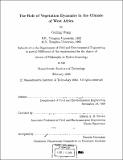| dc.contributor.advisor | Elfaith A.B. Eltahir. | en_US |
| dc.contributor.author | Wang, Guiling, 1971- | en_US |
| dc.contributor.other | Massachusetts Institute of Technology. Dept. of Civil and Environmental Engineering. | en_US |
| dc.date.accessioned | 2005-06-02T15:25:57Z | |
| dc.date.available | 2005-06-02T15:25:57Z | |
| dc.date.copyright | 2000 | en_US |
| dc.date.issued | 2000 | en_US |
| dc.identifier.uri | http://hdl.handle.net/1721.1/17486 | |
| dc.description | Thesis (Ph.D.)--Massachusetts Institute of Technology, Dept. of Civil and Environmental Engineering, 2000. | en_US |
| dc.description | Includes bibliographical references (p. 211-224). | en_US |
| dc.description.abstract | The climate of West Africa exhibits significant variability at the time scale of decades. The persistent drought of the past three decades is an example of such variability. This study investigates the role of vegetation dynamics in shaping the low-frequency variability of the climate over West Africa. A zonally symmetric, synchronously coupled biosphere-atmosphere model (ZonalBAM) which includes explicit representation of vegetation dynamics has been developed, and has been validated using observations on both the atmospheric and biospheric climate. The model is then used to study the dynamics of the coupled biosphere-atmosphere system over West Africa. Based on the model sensitivity to initial conditions and the resilience of the coupled system with respect to perturbations, we demonstrate that the coupled biosphere-atmosphere system over West Africa has multiple equilibrium states, with reversible transitions between different equilibria. The two-way biosphere-atmosphere feedback is a significant process in both climate persistence and climate transition. Based on long-term climate simulations using ZonalBAM driven with the observed sea surface temperature (SST) variations, our study shows that vegetation dynamics is a significant process in shaping the climate variability of West Africa. The response of the regional climate system to large-scale forcings is significantly regulated by vegetation dynamics. The relatively slow response of vegetation to changes in the atmosphere is a significant mechanism that acts to enhance the low-frequency rainfall variability. Climate transitions between different equilibria act as another mechanism contributing to the low-frequency rainfall variability - multi-decadal fluctuations can take place as a collective reflection of climate persistence at one equilibrium and climate transition towards another. Vegetation dynamics seems to play an important role in the development and persistence of the current Sahel drought. The most likely scenario for the triggering mechanism of the Sahel drought would involve a combination of several processes including regional changes in land cover as well as changes in the patterns of global and regional SST distributions. However, regardless of the nature of the triggering mechanism, the response of the natural vegetation to the atmospheric changes is the critical process in the development and persistence of the observed drought. | en_US |
| dc.description.statementofresponsibility | by Guiling Wang. | en_US |
| dc.format.extent | 224 p. | en_US |
| dc.format.extent | 9321183 bytes | |
| dc.format.extent | 9320990 bytes | |
| dc.format.mimetype | application/pdf | |
| dc.format.mimetype | application/pdf | |
| dc.language.iso | eng | en_US |
| dc.publisher | Massachusetts Institute of Technology | en_US |
| dc.rights | M.I.T. theses are protected by copyright. They may be viewed from this source for any purpose, but reproduction or distribution in any format is prohibited without written permission. See provided URL for inquiries about permission. | en_US |
| dc.rights.uri | http://dspace.mit.edu/handle/1721.1/7582 | |
| dc.subject | Civil and Environmental Engineering. | en_US |
| dc.title | The role of vegetation dynamics in the climate of West Africa | en_US |
| dc.title.alternative | Vegetation dynamics in the climate of West Africa | en_US |
| dc.type | Thesis | en_US |
| dc.description.degree | Ph.D. | en_US |
| dc.contributor.department | Massachusetts Institute of Technology. Department of Civil and Environmental Engineering | |
| dc.identifier.oclc | 45164773 | en_US |
